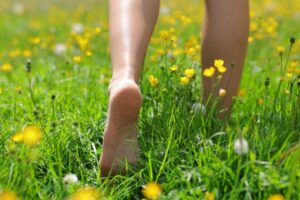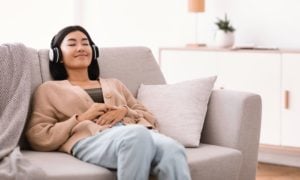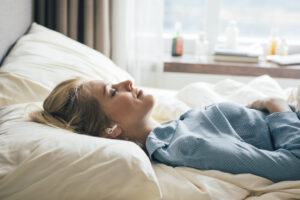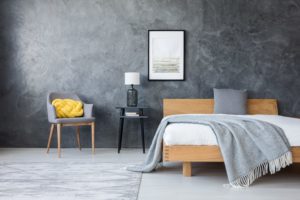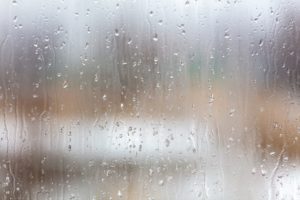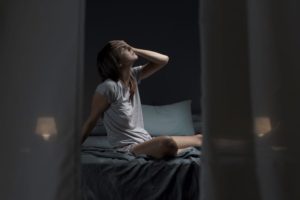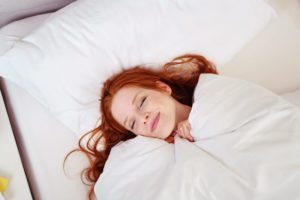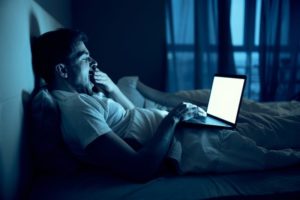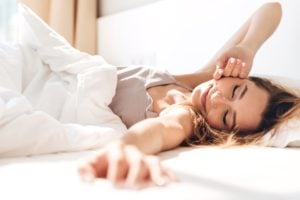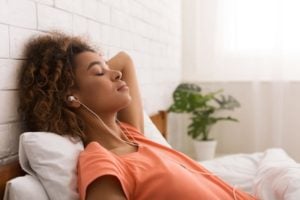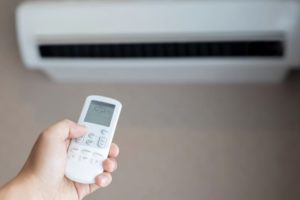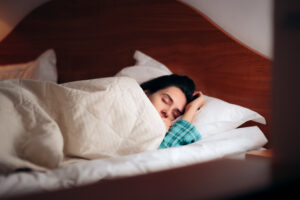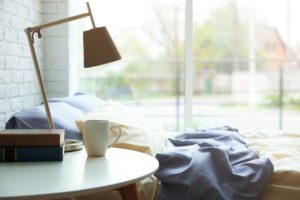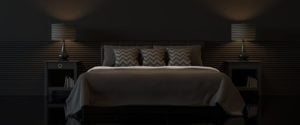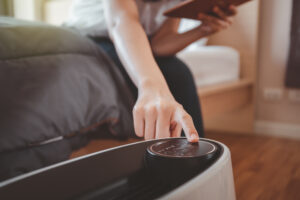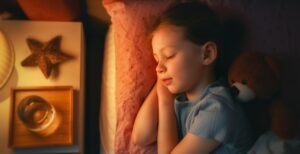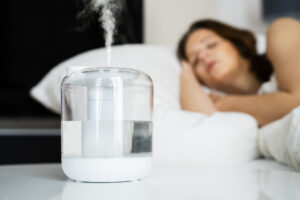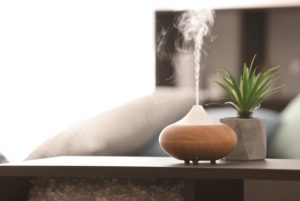Blue Light: What It Is and How It Affects Sleep
- Blue light is a wavelength of light often emitted by electronic devices and artificial lights.
- During the day, blue light influences your circadian rhythm, affecting alertness and heart rate.
- Limiting blue light at night can help mitigate its effects on sleep.
The screens of electronic devices such as smartphones, computers, tablets, and televisions can emit blue light that disrupts our natural sleep cycles. Research shows that a majority of Americans use electronic devices within an hour of going to bed, which can lead to unsatisfactory sleep. Decreasing exposure to light in the evening, and blue light in particular, is an important way to help your body naturally prepare for sleep and get quality rest.
Are You Getting Enough Deep Sleep?
A variety of issues can cause degrade your sleep quality. Answer three questions to understand if it’s a concern you should worry about.
What Is Blue Light?
Light is composed of electromagnetic radiation, which is an invisible form of energy. Our eyes interpret colors of light based on the amount of energy they contain. White light, including some light emitted by the sun, is the combination of all the colors of the visible light spectrum.
Blue light is a portion of the visible light spectrum that can influence alertness, hormone production, and sleep cycles. This wavelength of light is emitted by LED and fluorescent lights, as well as many electronic devices.
How Does Blue Light Affect Circadian Rhythms?
Circadian rhythms are finely tuned, 24-hour cycles that signal our bodies to carry out essential functions , including sleep. Light is the most important factor in aligning circadian rhythms and, for much of human history, these rhythms were closely aligned with sunrise and sunset .
With the advent of artificial light and electronics, people are being exposed to increased amounts of light before bedtime. While all types of visible light can affect circadian rhythms, blue light has the largest impact .
We get most of our exposure to blue light from the sun. Blue light stimulates parts of the brain that make us feel alert , elevating our body temperature and heart rate. During the day, blue light can improve performance and attention, tuning our circadian rhythms and setting us up for a better night’s sleep after the sun sets.
Strategically timed exposure to blue light can help treat several sleep disorders. Circadian rhythm disorders occur when a person’s circadian rhythms are not in alignment with their environment. Light therapy, and blue light in particular , can help realign the body’s circadian rhythms and improve sleep.
Inversely, exposure to blue light in the hours leading up to bedtime can hinder sleep. Blue light suppresses the body’s release of melatonin , a hormone that makes us feel drowsy. While this promotes wakefulness during the day, it becomes unhelpful at night when we are trying to sleep. Being exposed to blue light in the evening can trick our brain into thinking it is still daytime, disrupting circadian rhythms and leaving us feeling alert instead of tired.
Chronic misalignment of circadian rhythms can also lead to many negative health impacts , including metabolic disorders and mental health conditions such as depression. Being mindful of the sources of blue light and daily exposure levels can help reduce the risk of these negative health outcomes.
What Devices Emit Blue Light?
Many people work under artificial lights and constantly interact with the screens of electronic devices. Being aware of these common sources of artificial blue light can help you strategically time exposure and avoid circadian rhythm disruptions.
Common sources of blue light include:
- Fluorescent lights
- LED lights
- Smartphones
- Televisions
- Computer screens
- Tablets
- E-readers
- Video game consoles
The good news is that the risks of nighttime blue light exposure can be reduced through relatively simple methods.

Mitigating the Effects of Blue Light
The most effective way to reduce exposure to blue light in the evening is to simply turn off the sources. This means dimming or reducing LED and fluorescent lighting in your home and turning off electronic devices after it gets dark outside.
Specialty glasses may also be helpful in reducing exposure to blue light. While they may not work for everyone, blue light blocking or amber glasses can reduce the melatonin-suppressing effects of bright light .
It may not always be feasible to turn off sources of blue light after dark, but there are a variety of ways to reduce blue light exposure that may be interfering with your sleep.
- Make it a routine: Set an alarm that reminds you to turn off electronics two to three hours before bedtime.
- Use a different lamp: If you enjoy reading in bed, try a lamp that emits red or orange light rather than blue.
- Learn to dim: Dim the brightness of your electronic screens, or use the “night mode” feature found on some devices.
- Try an app: If you need to use devices before bed, try out one of several smartphone and computer applications that can help reduce blue light emission.
- Improve your sleeping environment: If there are light sources in your bedroom that you are unable to dim or turn off, try using an eye mask to block them out once you are in bed.

Still have questions? Ask our community!
Join our Sleep Care Community — a trusted hub of sleep health professionals, product specialists, and people just like you. Whether you need expert sleep advice for your insomnia or you’re searching for the perfect mattress, we’ve got you covered. Get personalized guidance from the experts who know sleep best.
References
9 Sources
-
Sollars, P. J., & Pickard, G. E. (2015). The Neurobiology of Circadian Rhythms. The Psychiatric clinics of North America, 38(4), 645–665.
https://pubmed.ncbi.nlm.nih.gov/26600101/ -
Division of Sleep Medicine at Harvard Medical School. (2007, December 18). The drive to sleep and our internal clock., Retrieved March 14, 2023, from
http://healthysleep.med.harvard.edu/healthy/science/how/internal-clock -
Wright, K. P., Jr, McHill, A. W., Birks, B. R., Griffin, B. R., Rusterholz, T., & Chinoy, E. D. (2013). Entrainment of the human circadian clock to the natural light-dark cycle. Current Biology, 23(16), 1554–1558.
https://pubmed.ncbi.nlm.nih.gov/23910656/ -
Wahl, S., Engelhardt, M., Schaupp, P., Lappe, C., & Ivanov, I. V. (2019). The inner clock: Blue light sets the human rhythm. Journal of Biophotonics, 12(12), e201900102.
https://pubmed.ncbi.nlm.nih.gov/31433569/ -
Vandewalle, G., Maquet, P., & Dijk, D. J. (2009). Light as a modulator of cognitive brain function. Trends in cognitive sciences, 13(10), 429–438.
https://linkinghub.elsevier.com/retrieve/pii/S1364661309001685 -
Gooley J. J. (2008). Treatment of circadian rhythm sleep disorders with light. Annals of the Academy of Medicine, Singapore, 37(8), 669–676.
https://pubmed.ncbi.nlm.nih.gov/18797560/ -
Lockley, S. W., Brainard, G. C., & Czeisler, C. A. (2003). High sensitivity of the human circadian melatonin rhythm to resetting by short wavelength light. The Journal of clinical endocrinology and metabolism, 88(9), 4502–4505.
https://academic.oup.com/jcem/article/88/9/4502/2845835 -
Jagannath, A., Taylor, L., Wakaf, Z., Vasudevan, S. R., & Foster, R. G. (2017). The genetics of circadian rhythms, sleep and health. Human molecular genetics, 26(R2), R128–R138.
https://pubmed.ncbi.nlm.nih.gov/28977444/ -
Shechter, A., Kim, E. W., St-Onge, M. P., & Westwood, A. J. (2018). Blocking nocturnal blue light for insomnia: A randomized controlled trial. Journal of Psychiatric Research, 96, 196–202.
https://pubmed.ncbi.nlm.nih.gov/29101797/


